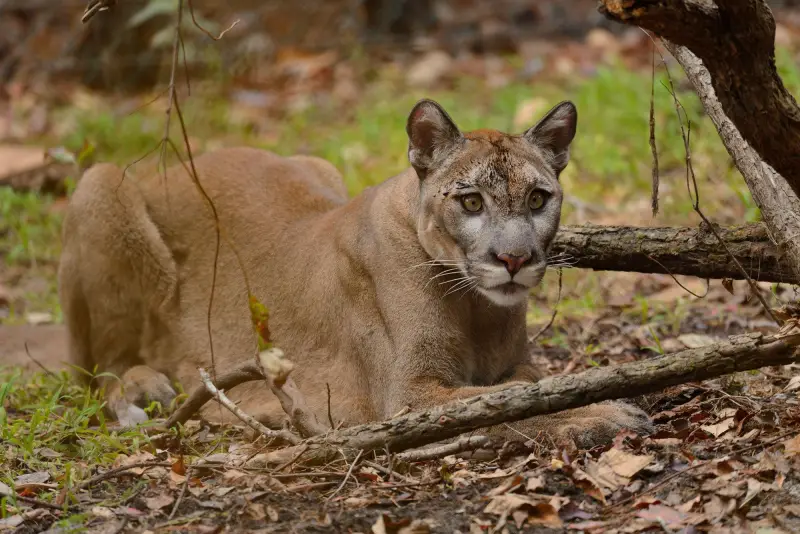When most people think about wildlife in Florida, they imagine alligators sunbathing by the water’s edge or colorful birds darting through the wetlands. However, few realize that one of the most elusive and majestic predators in the United States still roams wild in the Sunshine State: the Florida panther. This incredible big cat, a subspecies of the cougar, holds a remarkable story of survival, mystery, and ongoing conservation efforts.
For decades, the Florida panther was believed to be extinct, with only rumors and occasional sightings fueling hope for its continued existence. Today, thanks to dedicated conservation, there is a small but stable population living primarily in the forests and swamps of southern Florida. But how did this majestic animal survive, and what makes the Florida panther so unique? Let’s dive deep into the world of these elusive cats and uncover the truth behind the panthers of Florida.
What Is a Florida Panther?

The Florida panther is a subspecies of the cougar, also known scientifically as Puma concolor coryi. These large cats are closely related to mountain lions and pumas found throughout North and South America but have developed unique adaptations to the subtropical environment of Florida. Panthers are solitary, territorial animals with remarkable stealth and agility, making them apex predators in their habitat.
Physically, Florida panthers tend to be smaller and more compact than their western cousins, with males weighing between 100 and 160 pounds, while females are generally smaller. Their coats are tawny brown with a reddish hue, and they have a long tail often tipped in black. One distinct trait of Florida panthers is their rounded ears and slightly shorter legs, adaptations that help them navigate dense forests and swamps.
Historically, Florida panthers were widespread across the southeastern United States, ranging from Louisiana and Texas through Florida. However, habitat destruction, hunting, and vehicle collisions drastically reduced their numbers during the 20th century. By the 1980s, it was believed only a few dozen remained, confined mainly to the Big Cypress Swamp and Everglades.
The Remarkable Survival Story
The survival of the Florida panther is a story marked by resilience and human intervention. In the 1970s and 1980s, scientists feared the species might vanish completely. With such a small population, inbreeding depression threatened their genetic health, causing physical deformities and reduced fertility. Conservationists knew urgent action was needed to save this iconic animal.
One pivotal conservation effort involved introducing cougars from Texas to increase genetic diversity. This intervention helped boost the population and improve overall health, although Florida panthers still face significant challenges. The cats depend on large tracts of wild land to hunt deer, wild hogs, and other prey, but development and roads continue to fragment their habitat.
Today, estimates suggest that there are about 120 to 230 Florida panthers remaining in the wild, mostly in protected areas like the Big Cypress National Preserve, Everglades National Park, and surrounding lands. Despite their endangered status, these cats have made a remarkable comeback given the odds, inspiring hope for the preservation of Florida’s natural heritage.
Habitat and Behavior of Florida Panthers
Florida panthers primarily inhabit forested swamps, hardwood forests, and pinelands. They are highly secretive creatures, mostly active during twilight and night, avoiding human encounters. Their preferred habitats provide dense cover for stalking prey and access to water sources. Panthers are territorial animals, with males maintaining large territories of up to 200 square miles, overlapping smaller female ranges.
Their hunting skills are extraordinary. Panthers rely on stealth and patience, stalking prey such as white-tailed deer, wild hogs, raccoons, and armadillos. They are capable swimmers and can navigate waterways to pursue prey or cross between habitat patches. Panthers play a crucial role in controlling populations of herbivores, maintaining a balanced ecosystem.
Interestingly, Florida panthers mark their territory with scent markings and vocalizations, including screams and chirps, especially during the mating season. Cubs remain with their mothers for about a year before dispersing to establish their own ranges. This solitary lifestyle, combined with their low population density, makes encounters with humans extremely rare.
Threats Facing Florida Panthers
Despite their resilience, Florida panthers face ongoing threats that jeopardize their future. Habitat loss remains the most significant challenge as urban development, agriculture, and road construction fragment their living space. This fragmentation not only reduces available territory but also isolates populations, limiting genetic exchange.
Vehicle collisions are another major cause of mortality for panthers. Roads cutting through their habitats lead to fatal accidents, especially since these cats often cross highways at night. Efforts such as wildlife corridors and underpasses have been implemented in some areas to mitigate this risk, but challenges remain.
Human-wildlife conflict also occurs, especially as panthers sometimes prey on livestock or pets, leading to retaliation from landowners. Education and outreach programs aim to reduce such conflicts by promoting coexistence and informing the public about panther behavior.
Finally, disease and genetic issues linked to the limited gene pool continue to pose risks. Conservation biologists monitor populations closely and support efforts to maintain genetic diversity through careful management.
Conservation Efforts and Success Stories
Florida panther conservation is considered one of the most successful wildlife recovery programs in the United States. The introduction of Texas cougars in the 1990s, combined with habitat protection and scientific research, has contributed significantly to the species’ rebound.
Several government agencies, non-profit organizations, and academic institutions collaborate on monitoring and protecting panthers. They use GPS collars and camera traps to study panther movements, behaviors, and health. These tools help identify critical habitats and threats, informing management decisions.
Protected areas such as the Big Cypress National Preserve and Everglades National Park serve as strongholds for the species. Efforts to expand and connect these habitats, including the creation of wildlife corridors, aim to enhance genetic flow and reduce road mortality.
Community involvement is vital. Programs encourage residents and landowners to participate in conservation by reducing attractants, using panther-friendly fencing, and reporting sightings responsibly. Public education has also fostered greater appreciation for these magnificent cats.
Why Florida Panthers Matter
Florida panthers are not just another animal; they are an essential symbol of the state’s wild heritage and ecological health. As apex predators, they help regulate prey populations, preventing overgrazing and promoting biodiversity. Their presence signals intact, functioning ecosystems that support countless other species.
Beyond their ecological role, panthers have cultural significance. They inspire stories, folklore, and conservation ethics in Florida and beyond. Protecting panthers means preserving a connection to nature and the wild places that define the region.
Moreover, the panther’s recovery story offers hope and lessons for conservation worldwide. It demonstrates that with science, funding, and public support, endangered species can rebound from the brink of extinction.
How You Can Help Protect Florida Panthers
Anyone passionate about wildlife can contribute to panther conservation. Supporting organizations dedicated to protecting Florida’s natural habitats is one way. These groups work tirelessly to preserve land, advocate for responsible development, and conduct vital research.
Responsible recreation is also important. When visiting panther habitats, staying on trails, minimizing disturbance, and respecting wildlife ensure panthers can thrive without human interference. Reporting panther sightings to wildlife authorities helps track populations and detect emerging issues.
Additionally, spreading awareness about the plight and importance of Florida panthers helps build a community of advocates. Education fosters coexistence and reduces fear or misconceptions about these shy predators.
Conclusion
The presence of Florida panthers in the wild is a testament to nature’s resilience and humanity’s ability to change course. From near extinction to a fragile recovery, these majestic cats continue to roam the forests and swamps of southern Florida, embodying both mystery and hope. While challenges remain, ongoing conservation efforts and public support offer a promising future.
So yes, you can believe there are panthers in Florida—wild, powerful, and vital to the state’s ecological tapestry. By understanding, appreciating, and protecting them, we ensure that generations to come will witness the silent footsteps of the Florida panther in the heart of the Sunshine State.
FAQs about Florida Panthers
What exactly is a Florida panther?
The Florida panther is a subspecies of cougar (Puma concolor coryi) native to southern Florida. It is smaller and more compact than other cougars, adapted specifically to the subtropical forests and swamps of the region.
Are Florida panthers endangered?
Yes, Florida panthers are classified as endangered. Their population was critically low in the late 20th century but has seen modest recovery due to intensive conservation efforts.
Where do Florida panthers live?
They primarily inhabit the forests, swamps, and pinelands of southern Florida, including protected areas like Big Cypress National Preserve and Everglades National Park.
What do Florida panthers eat?
Florida panthers are carnivores and mainly hunt white-tailed deer, wild hogs, raccoons, armadillos, and smaller mammals. They rely on stealth and ambush tactics to catch their prey.
How many Florida panthers are left in the wild?
Current estimates suggest there are roughly 120 to 230 panthers in the wild, mostly confined to southern Florida’s protected habitats.
Why are Florida panthers important to the ecosystem?
As apex predators, they regulate prey populations, helping maintain balance in the ecosystem and supporting biodiversity across their habitat.
What threats do Florida panthers face?
Major threats include habitat loss, vehicle collisions, human-wildlife conflict, and genetic challenges due to a small population size.
How can humans help protect Florida panthers?
Support conservation programs, reduce habitat fragmentation, drive carefully in panther areas to avoid collisions, and educate communities about coexistence with these animals.
Are Florida panthers dangerous to humans?
Florida panthers are generally shy and avoid humans. Attacks are extremely rare. They tend to be elusive and active mostly at night.
Can you see Florida panthers in the wild?
Sightings are rare due to their secretive nature, but panthers can occasionally be spotted in protected areas or near wildlife corridors in southern Florida.






